Remove the fungus from the walls in the apartment. How to clean the fungus in the bathroom: popular and professional ways to remove mold and fungus
On the walls of premises with high humidity, it is often possible to spot mold stains, which pose a threat to the health of residents. Using information on how to remove the fungus in the bathroom and other rooms, you can get rid of pathogenic microflora with the help of folk or professional means.
Virtually every hostess had to face black spots, which are usually located in the bathroom or other rooms with high humidity.
Such a plaque should not be confused with dirt - it is usually caused by certain types of microscopic organisms.
Most often, the mold fungus colonies are formed in the upper part of the walls, from where they spread to the ceiling and vertical surfaces
Fungus of blue. This species of protozoa is able to reproduce only on wood, preferring structures from pine. Blue fungus can be found in bathhouses and saunas built from coniferous trees, but it does not threaten the inhabitants of urban apartments.
Bacteria of rotting (bacterial, brown, white rot) are also able to multiply only on the tree, causing the disintegration of cellulose fibers. It is extremely difficult to remove these microorganisms, stopping the process of destruction of wood. It is only possible to take measures in advance, treating the material with special fungicidal solutions.
The greatest danger to people is mold fungi, which form black spots. This group includes several representatives of microflora (Chaetomium, Ulocladium, Aspergillus and others). Black mold is able to settle not only on organic surfaces, but also on ceramic tiles, concrete, paint layer, brickwork.
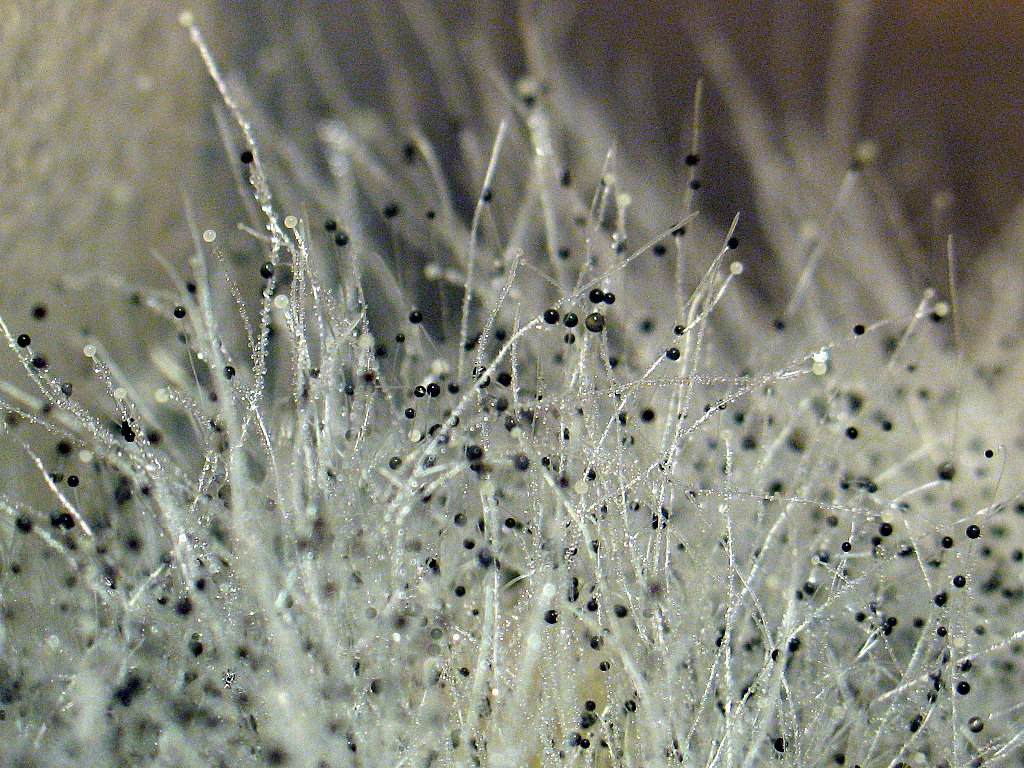
Considering the black plaque under a microscope, you can see that it consists of a multitude of tiny fungi, whose mycelium penetrates through any surfaces
Such a microflora should not be left without attention, it is desirable to take immediate measures to eliminate it.
Than the fungus on the walls is dangerous
The mold that appears in the rooms damages the building structures, and also negatively affects the health of the person.
Destruction of building materials
Fungus, settled on walls or ceiling, gradually destroys the material on which the colony settled. This can lead to flaking of the plaster, paint and varnish coatings, and in the started case even to the formation of cracks in the walls.
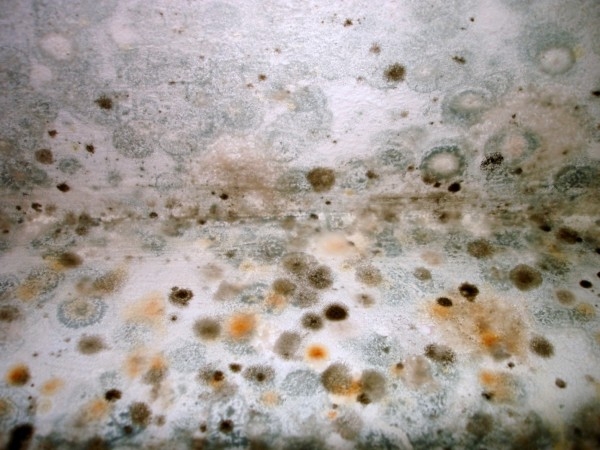
Mold colony stretches lime from concrete surfaces, as a result of this process, and also because of the action of the decomposition products in the pores, the internal stress
If you do not take appropriate measures, there may be a partial or complete destruction of individual building elements and even the collapse of surfaces.
Harm to human health
Pathogenic microflora has an extremely harmful effect on the human body, provoking a whole "bouquet" of various health problems. Mold is directly related to the following ailments:
- general exhaustion of the body;
- dermatoses, mycoses and a number of other skin diseases;
- headaches, dizziness;
- diseases of the respiratory system (from rhinitis and sinusitis to pneumonia and asthma);
- upset stomach, nausea;
- articular rheumatism and other problems of the musculoskeletal system.
Prolonged exposure to mold can lead to severe disruption of the lungs, kidneys, liver and other organs.
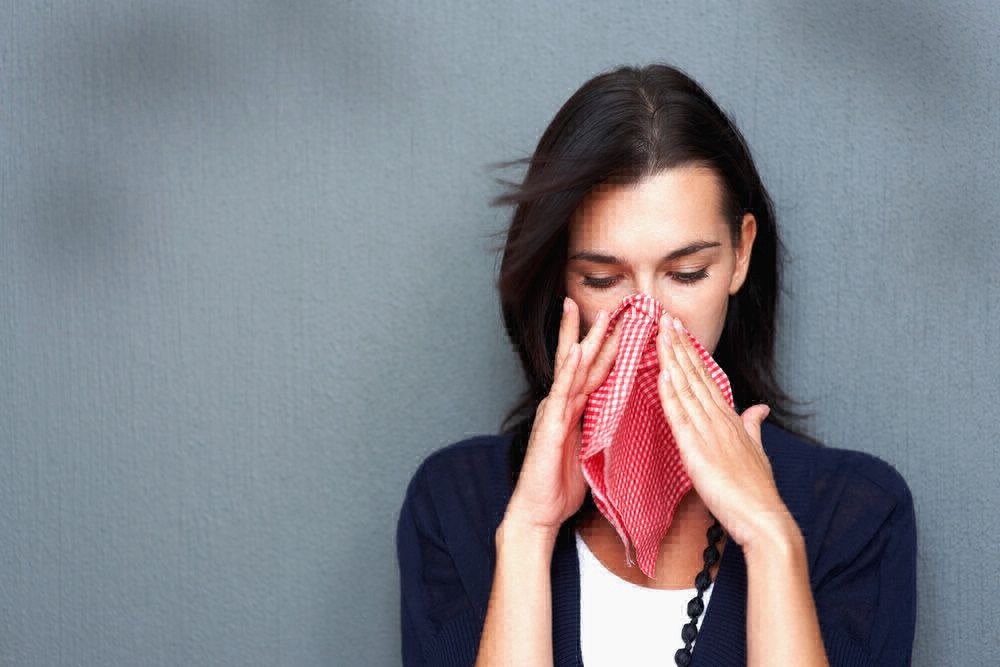
Sharp aggravation of health problems, for example, unexpected allergic reactions, can be caused by the growth of the fungus in the bathroom
Particularly sensitive to pathogenic microorganisms are people of advanced age, children, persons with weakened health and patients undergoing chemotherapy or antibiotic treatment.
Causes of fungus
In the air of almost any room, spores of various kinds of molds are sprayed, but their germination and reproduction can occur only under certain conditions: humidity of more than 30% and room temperature exceeding +20 о С.
To prevent the formation of colonies of microorganisms, it is necessary to take all measures to eliminate these causes. Especially important is the fight against humidity, as in a dry room the mold will not develop even with a warm and hot microclimate.
Preventing the occurrence of mold
To prevent the appearance of mold spots in the room, it is necessary to strictly follow a number of preventive measures.
It should be ensured that the room has good air circulation. As a rule, in all multi-storey houses there is a ventilation channel, however in old buildings it often does not cope with work. To rectify the situation, the channel can be cleaned (this can be done by a specially called VES employee) or an additional fan installation.
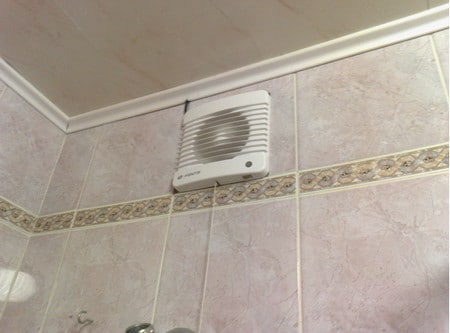
If with the help of natural ventilation it is not possible to maintain the required level of air humidity, you can use fans or household dehumidifiers
Even with excellent work of the hood after taking water procedures or washing it is desirable to leave the bathroom doors open: this helps to ventilate the room and remove excess moisture.
Do not supercool the space: it is desirable to cover a wall of a warm room with a layer of heat-insulating material.
With a weak heat transfer of the towel warmer, it is better to use additional heating equipment. This is especially true for the autumn-winter season, when the air temperature decreases and humidity increases.
It is necessary to monitor the appearance of condensation on pipes, furniture and other surfaces of the bathroom. Perform the droplets immediately wipe with a cloth or rags.
It is important in time to identify and eliminate the causes of high moisture content in the room. It is necessary to constantly monitor the condition of the mixers and sanitary devices, as well as the connecting elements.
Metal pipelines in the bathroom should be replaced with plastic analogs: they are more resistant to leakage and never covered with sweat.
Do not forget to pay attention to the little things: stagnant water in the toothbrush cups, can cause molding of mold on their handles. Colonies of fungi can also settle on the polymeric curtains separating the bath or shower.
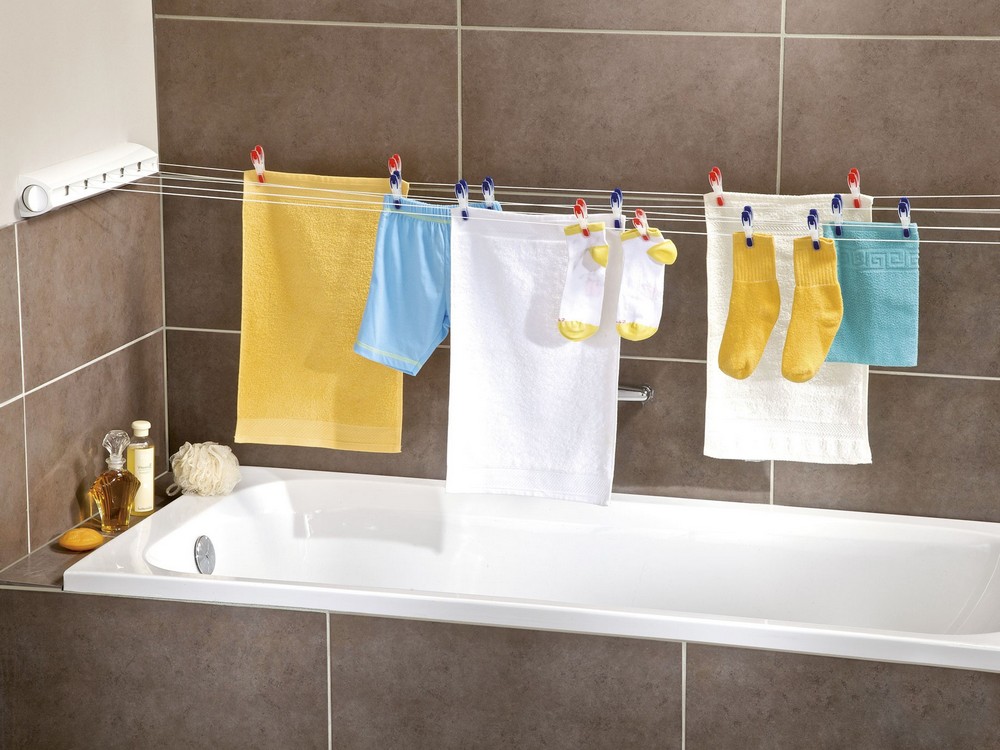
Do not dry clothes in the bathroom. This increases the humidity in the room, which contributes to the development of mold fungus colonies
When repairing a bathroom it is necessary to use special construction and finishing materials that prevent the appearance of fungus.
It is important to periodically carry out preventive surface treatment using folk methods or household chemicals specifically designed for this purpose.
Mechanical method of removing fungus
Having found out in the room black spots, the mistress usually takes up a rag or a scraper, trying to wash or scrape off the mold. To get an effective result, you need to know how to properly withdraw the fungal colonies in the bathroom.

The simplest method of fighting mold is mechanical removal, but this method produces the desired result only at an early stage of the lesion
First of all, the found areas of mold should be well moistened with water. This manipulation will prevent fungal spores from entering the air, which can cause new lesions.
Then you need to take a metal scraper or another similar tool (steel brush, drill with a grinding head), which will help to carefully remove the affected area of the surface.
It is desirable to remove as much as possible of the coating layer (plaster, wallpaper, paint); For materials such as concrete and wood, milling is also possible.
In advanced cases, this method is not effective enough, because the mycelium can penetrate deeply into even inorganic surfaces, for example, to hide under a tile.
In this case, in order to solve the problem, it is necessary to carry out major repairs, including:
- liberation of walls from decorative coating ( ceramic tiles, wallpaper, paint layer);
- removal from the ceiling of a lime or paint coating;
- replacement of flooring material.
When carrying out overhauling, it is absolutely necessary to treat all surfaces with means that destroy the fungus. Preparations (folk or professional) should be applied to an area that exceeds the size of the visible area of the fungus in order to remove the micro-fungus invisible to the naked eye.
Each surface must be treated at least 2-3 times, each time waiting for the complete drying of the previously applied fungicidal drug. When repairing it is desirable to use building materials with antifungal additives.
Folk methods of mold removal
Since mold fungi have troubled people for centuries, and household chemicals have been produced not so long ago, the population has accumulated a lot of experience in using a variety of means to destroy harmful microflora.
Among the most common drugs with a pronounced effect, we can name the following.
Option # 1: copper vitriol
Inexpensive effective means, which can be purchased in garden, garden, construction or household stores. Blue crystals are bred in warm water in a proportion of 200-300 grams of powder per 10 liters of liquid, after which they mix well.
The process of treating the affected surface with a prepared solution is carried out in several stages:
- Traces of mold on the walls are cleaned with sandpaper or a spatula.
- The prepared places are wiped with a soap solution, which increases the effectiveness of the used product.
- Cleaned and washed surfaces give time to dry.
- Wall is being processed copper sulfate (the solution can be applied using a kitchen sponge or sprayer).
- The surface is left for 3-5 hours to dry, after which it is again applied diluted vitriol.
- Depending on the extent of the fungus, the procedure is repeated 2-5 times.
For greater efficiency in a solution of vitriol, you can additionally make a tablespoon of vinegar.
Option # 2: chlorine-containing products

Funds that contain chlorine have a pronounced antifungal effect. However, they can not be used simultaneously with ammonia to avoid reaction
To combat mold colonies, the affected areas and the area around them are treated with a rag that is wetted in undiluted substance. For treatment of interlacing joints, the preparation can be diluted with water in a proportion of 1 to 1, pour into a spray gun and apply to the seams.
Option # 3: table vinegar
Virtually every house has a 6-9% vinegar solution, which is widely used in cooking. At the same time, this remedy is a good antiseptic, which perfectly destroys various types of microflora. To combat mold, you should:
- treat the affected area with table vinegar: a smooth surface (tile) is enough to wipe with a sponge or a cloth soaked in a liquid, and sprinkle the loose coatings (plaster, concrete, wood) from the spray gun;
- leave the treated surface for 2-3 hours before drying;
- remove residual fungus with a brush;
- rinse thoroughly with clean water;
- ventilate the room well to remove a pungent odor.
It should be borne in mind that in some cases from vinegar on the wall may remain a divorce.
Other folk remedies for fungus
In addition, the following preparations can be used as antibacterial and fungicidal agents:
- Hydrogen peroxide. A widely used antiseptic, a 3% solution of which can be purchased at a pharmacy. The drug is not toxic and has no pronounced odor. Care must be taken in processing, as peroxide has an obvious bleaching effect.
- Ammonia. A good means for removing mold colonies from dense hard surfaces, such as ceramic tiles or glass. To destroy microflora, the drug purchased at the hardware store is diluted with an equal amount of water, after which the mixture is applied to the infected area with a sponge or sprinkler. The solution is left on the wall for several hours, after which the coating is thoroughly washed.
- Baking soda. A natural and safe household antiseptic, which will help in the fight against fungus. For processing, use a solution of a teaspoon of powder mixed in a glass of water. The solution is sprayed with a surface on which a fungus is seen, or the wall is washed with a sponge soaked in a composition. To wash off soda it is not obligatory, it can be safely left on a tile or other covering.
- Tea tree oil. Eco-friendly, with a strong pleasant aroma, suitable for the prevention and destruction of small areas of mold. For use, you need to dissolve in half a liter of water two teaspoons of essential oil, which you can buy at a pharmacy or a specialized store. The resulting solution is sprayed into the areas where the presence of the fungus is expected. It should not be washed off, but after treatment it is best not to enter the bathroom for 12 hours.
- Creosote. Based on tar, the yellowish liquid with a sharp odor is applied as a solution in alcohol or ether. The drug is recommended to be applied to concrete, tiles, plastic panels, bricks and other smooth, dense surfaces. After drying, it must be washed off with water and soap. It is undesirable to use creosote for processing of wooden constructionsBecause the solution instantly penetrates into loose textures.
- Anthracene oil. Greenish liquid with a specific odor is produced from coal. Oil is considered a good preventive means, preventing the appearance of mold deposits on the walls.
- Bura. Mineral, which is a natural antiseptic. To treat the surface with sprouted mold, it is necessary to prepare a solution of 2.5 liters of liquid and 1 cup of borax. After cleaning the wall from stains on it with a rag, a rather thick composition is applied. It is not required to wash it off, but after drying it is possible to wipe the surface with dry paper to remove the crystals that protruded. Another option: make a less concentrated solution (a full glass of borax and 4 liters of liquid), and then spray the affected area from the spray gun.
- Camphor balls. For the prevention of fungal infection in the room can be decomposed camphor balls.
- Iodine. Another preventive agent is iodine vapor. To do this, a glass of water is placed on the shelf in the bathroom, in which 10 mg of the usual iodine tincture is diluted. It is advisable that there are no metal objects nearby, as volatile vapors of iodine can cause corrosion.
Do not forget about cleaning "cocktails."
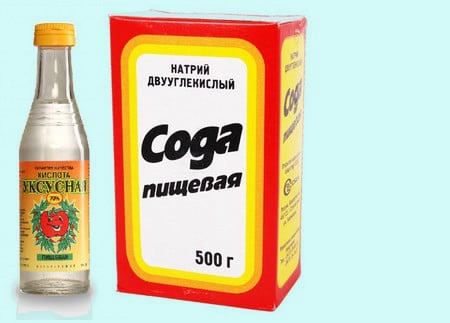
For the treatment of moldy spots, a combined method can be used. Surface should be treated with soda or soda solution, and then moistened with table vinegar. After the foam settles, the remnants of the products are washed off with soapy water
An effective preparation is also a preparation prepared from 4 parts of water, 2 parts of hydrogen peroxide, 1 part of boric acid, 2 parts of vinegar. All components are mixed well, after which the mixture is wetted with a rag or sponge, to which all affected areas are treated.
Professional methods of killing fungus
With extensive fungal damage to the surfaces of the bathroom, it is better to use professional methods of mold destruction.
Means of household chemistry
On sale there are many different means for fighting the pathogenic microflora.

Before buying an antifungal agent, you need to carefully read the product annotation to determine how suitable it is for the surface material and the purpose of the treatment
"Mil Kill" - an emulsion, which includes an antiseptic, safe for human health. The preparation is especially recommended for the treatment of complex surfaces made of materials with a fine-porous structure. The same means can be used for disinfection of places of leaks, as well as for protecting structures located in areas of high humidity.
"Isocid" - a line of drugs designed to destroy various types of microflora, typical for rooms with a high content of water vapor. Means can be used for processing of bases made of wood, stone, concrete, and also used as a base for the preparation of water-soluble paints.
Well Done - a modern antibacterial solution, suppressing the development of fungi, mold, algae. It has a pronounced instantaneous result, it copes well even with large colonies of microorganisms. Well suited for sanitation of internal and external surfaces, suitable for the treatment of wooden, plastered or painted with paint.
"Titan" Fungicide. Means intended for the removal of fungus and mold from internal and external paint and varnish, without removing the layer of finishing material. The composition can also be used for prevention.
SZAVO (Savo). Effective drug designed to combat pathogenic microflora in rooms where it is difficult to get rid of the increased content of water vapor (kitchens, bathrooms, cellars, showers). The manufacturer guarantees 100% destruction of mold, algae, fungi. The agent is extremely simple to use: it does not require preliminary surface treatment and additional washing.
Astonish is an excellent remedy for removing mold from "light" surfaces that do not require scraping. It can be used for cleaning polymeric shower curtains, plastic furniture, tiles.

The popular "Antifungus" can be added to the glue for gluing wallpaper, which will protect the surface from the possible appearance of mold
"Antifungus" - a universal tool that can be used to treat areas affected by the fungus, or as a preventive measure. The drug is applied to virtually all types of materials: brick, wood, concrete, plaster.
Dali - a completely transparent antiseptic drug, made on a water basis. Excellent for preventing and eliminating fungus on wooden structures.
Domestic and imported manufacturers also produce a wide range of paints, grouts, primers and other types of building materials that contain fungicidal components that guarantee surface protection.
Sanitation and ionization of the room
To combat the fungus in the bathroom, the treatment of affected areas with an air jet is also used, which is further enriched with ions and trace elements. Since the special equipment intended for this purpose is quite expensive, the work is usually carried out by specially trained professionals.
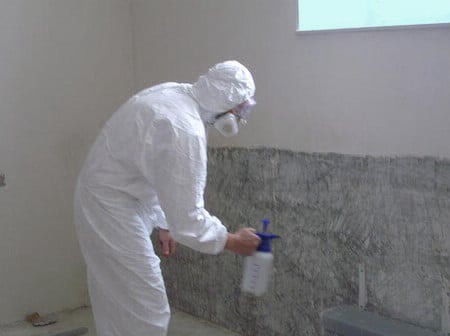
If dark spots cover most of the wall, it is advisable to contact special services whose employees will professionally process the surface
To conduct large-scale work on the removal of mold, aggressive chemicals are also used, the use of which requires special precautions. Treatment with similar drugs is carried out by specialists who have been trained.
Safety rules for the processing of premises
All manipulations to remove mold are dangerous work, because when they are performed on the skin and mucous membranes can get harmful spores of fungi. In addition, when working on surfaces, highly potent substances are used, which can cause burns, poisoning and other negative reactions.

All work is better done in personal protective equipment to prevent the ingress of mold and corrosive chemicals into the respiratory organs
To prevent this, it is necessary to take special precautions. When carrying out work, wear:
- durable rubber gloves, protecting the palms and wrists;
- respirators or masks for respiratory organs;
- plastic glasses (preferably special, snugly adjacent to the eye sockets), providing effective eye protection.
After completion of work, the protective equipment used, especially gloves and respirators, is recommended to be discarded.
When processing the bathroom, all small items should be removed from the room, and large ones should be covered with a protective film, which should then be carefully collected and taken out.
Perform activities to destroy the fungus in the absence of children and pets. The treated room should be well ventilated for 2-4 hours, after which it is better not to use the bath for 2-3 days.
The video below shows how you can remove the fungal colonies in the bathroom, applying modern types preparations of household chemical goods.
The fight against mold should be kept constantly. After the destruction of the fungus in the bathroom with the help of folk or professional tools it is important to follow all the recommended preventive measures that will help to avoid the appearance of new foci.
Many are convinced that the mold and fungus on the walls are found only in neglected groomed apartments or in damp cellars. And they are genuinely surprised when they encounter these unpleasant phenomena in their home.
Why is mold dangerous and why does it occur?
First you find only one small black point, but the fungus quickly starts multiplying in suitable conditions for it. In a short time you will notice a large number of spots, yet not very scary in appearance. Most residents do not show concern, they plan to eliminate the problem when time and money appear, but delay can cause serious health problems. It is necessary to know that black fungus can develop: asthma attacks, asthma and allergies, chronic nasal congestion, conjunctivitis, stomatitis and dermatitis, bronchitis, laryngitis and other respiratory diseases. The main cause of the fungus on the walls is dampness. Most often people face this problem with the onset of autumn, when central heating is not yet turned on, and on the street - cold and humid. Before removing the fungus on the walls, it is necessary to determine exactly the causes of dampness in your apartment. This may be a lack of air circulation, incorrectly functioning ventilation or its complete absence, poor external walls and inter-panel joints, as well as residual moisture after the repair.
So, first of all, you need to establish a constant airing of housing. All furniture should be moved away from the affected areas in order to improve air circulation. The main focus of the problem is the bathroom, so it is better to keep the door open for better airing. However, one must understand that these measures will only halt the development of the fungus, because its controversy already exists on the walls and inside them, so it will still have to be eliminated.
Means for removing fungus
Mold can be removed with the help of special antiseptic agents, which are in huge numbers on the shelves of building stores. It should be understood that any chemical agent to remove mold is a poison, so work with it must be extremely cautious. Before use, you should carefully read the instructions. Some porous materials, upholstered furniture can be so impressed by the mold in the depth that it is almost impossible to clean them, so they will have to be thrown out.
The best means to get rid of mold is a special antiseptic primer, it is easy to find in the appropriate store. It not only helps to get rid of mold, but also protects from its appearance in the future. Such a primer is very simple to use, as a rule, it does not need to be diluted with water. If the product is undiluted, then you should follow the instructions carefully to get the right composition for mold control. Before applying the primer, the surface must be cleaned. If the plastered wall is strongly affected by the fungus, it is important to clean it to a clean layer, down to the concrete slab or brick. Primer should be applied to a dry surface with a paint brush. When it completely dries, you can apply paint or glue wallpaper.
In the fight against can help and home remedies. Of course, they are not as effective as a special primer, but they are less toxic. The usual bleach is able to cope with almost all types of mold in the house. Its active substance - sodium hypochlorite, kills both mold itself and its spores. Bleach can be used for tiles in the bathroom, glass or floor, but remember that many things are discolored and spoiled under its influence. In addition, this substance emits harsh and toxic fumes and corrodes the skin of the hands. Before using bleach, make sure that the room is well ventilated. Also, wear rubber gloves to protect your hands. It is necessary to mix 1 part of bleach with 10 parts of water, and the mixture obtained to process the surface.
An excellent antibacterial and antifungal agent is hydrogen peroxide. In any pharmacy you can buy a 3% solution of peroxide, it is not toxic and does not emit a pungent odor. Hydrogen peroxide removes mold very effectively, but it has a whitening effect, so it must be used with caution on painted surfaces.
Common table vinegar is a weak acid and can destroy many common types of mold. It has a smell, but does not emit dangerous vapors. To remove mold, vinegar must be applied to the affected surfaces with a spray or wipe with a damp cloth. After an hour, the wall needs to be washed with water and ventilated. To prevent the occurrence of fungus, vinegar can be sprayed into the problem area every week.
Also, ammonium hydroxide is often used to kill mold. It perfectly removes the fungus on hard non-porous surfaces (tiles or glass), but is not suitable for porous materials. Ammonia alcohol must be mixed with water in equal amounts and the resulting mixture sprayed onto the infected area. After a few hours it needs to be washed. Remember that the pungent smell of ammonia can cause headache and choking in the throat. In addition, it is not recommended to mix it with bleach, since this releases a toxic gas.
Perfectly fights with fungi baking soda. It is known as a natural and safe household cleaner. Unlike other products, soda does not contain aggressive chemicals, it does not hurt the family or pets. A teaspoon of soda should be dissolved in a glass of water and the resulting mixture sprayed on the affected surface. And you can just rinse with a sponge in a solution of soda surface. It is advisable not to wash off the soda from the surface completely, as it protects well against the re-occurrence of dangerous contaminants.
Preventing the appearance of mold
As you have already understood, the main reason for the spread of mold is insufficient ventilation of rooms. It is worth checking the traction in their ventilation ducts with the help of a lit match. If the flame of the match does not deviate to the side of the channel, then there is no thrust. In this case, you need to contact the district communal service.
The next reason for poor quality can be called plastic windows of increased tightness. To ensure the supply of fresh air, install the ventilation valves on the windows. Also, you do not need to put furniture close to the walls, which are covered with wallpaper, because it is in such enclosed places that mold occurs most often. To avoid mold on the walls, spend frequent airing the room. It is recommended that you periodically open windows and windows in the house for short periods of time. The jambs of window openings should preferably be painted with hydrophobic paints.
The increased dampness of building materials and other shortcomings in repair are also causes of increased humidity and fungus formation. The usual rain, which does not flow down drains, but directly on the outside of the wall of the house, can lead to its soaking through. Elimination of these problems must be demanded from the housing and communal office.
- Causes of fungus
- Fighting against mold
- Rules for eliminating the fungus
- Antifungal preparations
- Folk remedies against mold
Many people are faced with the problem of mold on ceilings and walls. It's a fungus. It can appear in the form of black dots on the walls, blueing or greening of surfaces, exfoliation. Fungus is dangerous to human health. Getting into the respiratory tract, mold spores cause an allergic reaction, asthma develops, irritation of the mucosa appears. Fungus can provoke serious skin diseases.
Formation of mold is most often due to high humidity in the house.
Causes of fungus
To understand how to deal with mold, you need to find out where it comes from. Favorable conditions for its appearance are created in damp, poorly ventilated rooms. But not only this can provoke the appearance of mold. The cause of the appearance of the fungus can be:
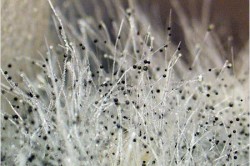
Mold spores are very harmful to the human body. Often there are colds and allergic reactions.
- freezing of external and access walls;
- cracks in brickwork;
- poorly sealed interpanel joints;
- made with a violation of the technology of plastering and finishing work, which did not meet the intervals of interlayer drying, installed by manufacturers;
- faulty engineering systems, leaking sewerage or water supply;
- the main reason, of course, is the violation of ventilation. Normal ventilation means, under itself, not instant airing when the window is open for a few minutes, the air exchange must be constant. Plastic windows seal the room completely, thereby violating its ventilation.
Back to contents
Fighting against mold
After the cause of the mold is established, it is possible to go to the most important stage - the removal of mold and fungus for good.
Elimination of the cause of this phenomenon is the key to solving this issue.
Only after this it will be possible to proceed to the final stage. What should I do to remove mold and fungus from the ceiling and walls?
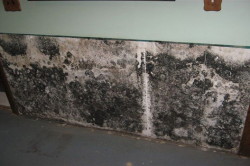
To fight mold, you must completely remove the wallpaper from the affected area and treat it with special compounds.
- Dismantling of the site of wallpaper, infected with a fungus.
- Clear the wall under it from whitewash, putty, plaster, paint. Using a spatula or a metal brush, thoroughly clean the brick surfaces, especially pay attention to the seams of the masonry.
- Build a dryer or heat fan to dry the wall. A blowtorch can help when drying brick and concrete walls.
- Surface treatment with special chemicals designed to remove fungus and mold. To avoid its further appearance, the product must be applied to the entire surface.
- Further, it is necessary to wait for complete drying of the surface and after 5 hours to re-treat.
- Using a special antiseptic primer, primed walls.
- The next stage will be the preparation and application of the waterproofing mixture to the treated areas.
- The walls are leveled with plaster or puttying (depending on the cleaned layer).
- Wait until the layer dries completely, primed and proceed to external finish.
Back to contents
Rules for eliminating the fungus
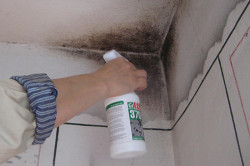
When performing operations to remove mold, a respirator must be used.
Using a primer will not only help get rid of the fungus, but also prevent it from reappearing. It is best to use a ready antiseptic primer. Most of these products can be used immediately after purchase without diluting them with water. If you still need to dilute the primer, then you need to do it strictly in accordance with the instructions.
Apply an antiseptic primer evenly. The surface must be dry and clean. To apply a primer, either a paintbrush or a paint spray gun is used. After 6 hours after the application of the antiseptic, the surface must be cleaned of debris. It needs to be washed clean water, dry and apply a coat of primer again. Decorative decoration can be done after a day.
If the fungus appeared due to freezing of walls or leakage of joints (cracks), in order to get rid of it forever, first of all it is necessary to seal all the seams and cracks, to make the insulation of the external and access walls and only after that remove the mold using technology, discussed above.
If you had to face a particularly severe case of structural damage, when the fungal focus spread to large areas, it becomes necessary to apply cardinal measures. It will be necessary to hollow out part of the concrete or burn out the affected area plasma welding or propane.
A few words about chemicals that help fight the fungus. If it has spread to a small volume of a wall, ceiling or slope, then the problem can be solved by one chemical treatment, using any special facility available on the store counter. But it will be necessary to apply it not only to the damaged area, but all the walls in the room will need to be treated. This should be done to neutralize all the fungus spores that have already spread to them, and, as soon as favorable conditions arise, will begin to multiply.
Back to contents
Antifungal preparations
It should be remembered that the treatment of affected areas of walls should be carried out in a respirator and gloves. The vapors of chemicals that a person inhales are dangerous to his health. Consider several antifungal agents:
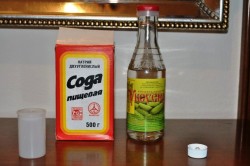
Soda and vinegar can prove to be no less useful in combating mold than special means. But they will be cheaper at times.
- "Nature Antimantar". This antibacterial primer is a water-based antiseptic, which is applied a thin layer on the surface. The film, which remains on it after drying, is transparent and has no odor. With this tool, you can not only remove the existing fungus, but also prevent its appearance in the future.
- "Biolavatio" not only destroys mold and cleans the surface of walls and ceiling, but also has a bleaching effect. The product is suitable even for surfaces that have suffered severe fungal attack.
- "Homeenposte". The composition of this product includes chlorine, which successfully removes mold from any concrete, wood, cement and any other surfaces.
- The Russian means "S-Hydrotex-P" is a dry mixture, which is used for the treatment of reinforced concrete bases. It is suitable for any apartment: bathroom, toilet, living room, kitchen.
There are tools that are an antifungal additive in wallpaper glue or in water-dispersion paint. They provide reliable protection of walls and ceiling from the appearance of fungus. Before using this product, it is necessary to test for compatibility with paint or glue.













